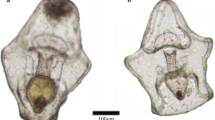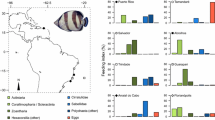Abstract
Despite facing similar constraints imposed by the environment, significant variation in life history traits frequently exists among species generally considered to comprise a single ecological guild. For juvenile flatfishes, constraints on foraging activity include variation in light and prey availability, as well as predation risk. This paper describes the visual constraints on, and divergent foraging strategies of three co-occurring north Pacific flatfish species, northern rock sole (Lepidopsetta polyxystra), Pacific halibut (Hippoglossus stenolepis), and English sole (Pleuronectes vetulus). Visual foraging abilities measured in the laboratory decreased rapidly below 10−4 μmol photons·m−2 s−1, and were similar among species. Despite similar sensory constraints, field sampling in August 2004 at a Kodiak Island nursery site (Holiday Beach, 57o41.2′ N, 152o27.7′ W) identified species differences in diets, diel foraging patterns, and within-nursery depth distributions. Northern rock sole and English sole fed primarily on bivalve siphons and polychaetes, whereas mysids dominated the diets of Pacific halibut. Northern rock sole were geographically the most widespread but feeding activity was temporally restricted to the dusk period. Pacific halibut were rare in shallow depths (<5 m) and fed most intensively prior to dusk. English sole fed throughout the daylight hours and were abundant only in the shallowest (<5 m) habitats. These differences in diets, foraging times, and habitat use appear related to previously documented species-specific behavioral characteristics as well as general spatial (increasing with depth) and temporal (increasing during foraging activity) variations in predation risk. At one extreme, the conservative behavioral strategy of northern rock sole may permit use of a broader range of foraging habitats, whereas English sole may be restricted to shallow water by limited behavioral responses to predation threat. These observations demonstrate that the appearance of habitat partitioning is not due to differences in sensory ability, but reflects multi-faceted, species-specific responses to the ecological tradeoffs between foraging and predation risks.





Similar content being viewed by others

References
Abello HU, Shellito SM, Taylor LH, Jumars PA (2005) Light-cued emergence and re-entry events in a strongly tidal estuary. Estuaries 28:487–499
Abookire AA, Norcross BL (1998) Depth and substrate as determinants of distribution of juvenile flathead sole (Hippoglossoides elassodon) and rock sole (Pleuronectes bilineatus), in Katchemak Bay, Alaska. J Sea Res 39:113–123
Bellwood DR, Wainwright PC, Fulton CJ, Hoey AS (2006) Functional versatility supports coral reef biodiversity. Proc R Soc Lond Biol 273:101–107. DOI 10.1098/rspb.2005.3276
Beyst B, Cattrijsse A, Mees J (1999) Feeding ecology of juvenile flatfishes of the surf zone of a sandy beach. J Fish Biol 55:1171–1186
Boehlert GW, Mundy BC (1987) Recruitment dynamics of metamorphosing English sole, Parophrys vetulus, to Yaquina Bay, Oregon. Est Coast Shelf Sci 25:261–281
Briones-Fourzán P, Pérez-Ortiz M, Lozano-Álvarez E (2006) Defense mechanisms and antipredator behavior in two sympatric species of spiny lobsters, Panulirus argus and P. guttatus. Mar Biol 149:227–239. DOI 10.1007/s00227-005-0191-2
Carter CG, Grove DJ, Carter DM (1991) Trophic resource partitioning between two coexisting flatfish species off the north coast of Anglesey, North Wales. Neth J Sea Res 27:325–335
de Groot SJ (1969) Digestive system and sensorial factors in relation to the feeding behaviour of flatfish (Pleuronectiformes). J Cons int Explor Mer 32:385–395
Darnaude AM, Harmelin-Vivien ML, Salen-Picard C (2001) Food partitioning among flatfish (Pisces: Pleuronectiformes) juveniles in a Mediterranean coastal shallow sandy area. J Mar biol Assn UK 81:119–127
Douglas RH, Hawryshyn CW (1990) Behavioural studies of fish vision: an analysis of visual capabilities. In: Douglas RH, Djamgoz MBA (eds) The visual system of fish. Chapman & Hall, London, pp 373–418
Evans HM (1937) A comparative study of the brains in pleuronectidae. Proc R Soc Lond Biol 122:308–342
Faria C, Almada V (2001) Microhabitat segregation in three rocky intertidal fish species in Portugal: does it reflect interspecific competition? J Fish Biol 58:145–159. DOI 10.1006/jfbi.2000.1434
Gibson RN (2005) The behavior of flatfishes. In: Gibson RN (ed) Flatfishes: biology and exploitation. Blackwell, Oxford, pp 213–239
Gill JL (1978) Design and analysis of experiments in the animal and medical sciences. Iowa State University Press, Ames
Grabe SA (1996) Feeding chronology and habits of Alosa spp. (Clupeidae) juveniles from the lower Hudson River estuary, New York. Environ Biol Fishes 47:321–326
Helfman GS (1986) Behavioral responses of prey fishes during predator–prey interactions. In: Feder ME, Lauder GV (eds) Predator–prey relationships: perspectives and approaches from the study of lower vertebrates. University of Chicago Press, Chicago, pp 135–156
Holladay BA, Norcross BL (1995) Diet diversity as a mechanism for partitioning nursery grounds of pleuronectids. In: Proceedings of the international symposium on North Pacific Flatfish Alaska Sea Grant College Program Report No 95–04. University of Alaska, Fairbanks, pp 177–203
Huber M, Bengtson DA (1999) Interspecific differences in growth of somatic and reproductive tissues during the breeding season in Menidia menidia and M. beryllina. J Fish Biol 55:274–287
Hunter JR (1968) Effects of light on schooling and feeding of jack mackerel, Trachurus symmetricus. J Fish Res Bd Can 25:393–407
Hurst TP, Abookire AA (2006) Temporal and spatial variation in potential and realized growth rates of age–0 northern rock sole. J Fish Biol 68:905–919. DOI 10.1111/j.1095-8649.2006.00985.x
Hurst TP, Duffy TA (2005) Activity patterns in northern rock sole are mediated by temperature and feeding history. J Exp Mar Biol Ecol 325:201–213. DOI 10.1016/j/jembe.2005.05.003
Job SD, Shand J (2001) Spectral sensitivity of larval and juvenile coral reef fishes: implications for feeding in a variable light environment. Mar Ecol Prog Ser 214:267–277
Krygier EE, Pearcy WG (1986) The role of estuarine and offshore nursery areas for young English sole, Parophrys vetulus Girard, of Oregon. Fish Bull 84:119–132
Langeland A, Abeelund JH, Jonsson B, Jonsson N (1991) Resource partitioning and niche shift in arctic charr Salvelinus alpinus and brown trout Salmo trutta. J Anim Ecol 60:895–912
Lankford TE, Billerbeck JM, Conover DO (2001) Evolution of intrinsic growth and energy acquisition rates. II. Trade-offs with vulnerability to predation in Menidia menidia. Evolution 55:1873–1881
Lemke JL, Ryer CH (2006a) Relative predation vulnerability of three juvenile (age–0) North Pacific flatfish species: possible influences of nursery specific predation pressures. Mar Ecol Prog Ser 000:000–000 (in press)
Lemke JL, Ryer CH (2006b) Risk sensitivity in three juvenile (age–0) flatfish species: does estuarine dependence promote risk prone behavior? J Exp Mar Biol Ecol 333:172–180
Lester NP, Dextrase AJ, Kushneriuk RS, Rawson MR, Ryan PA (2004) Light and temperature: key factors affecting walleye abundance and production. Trans Am Fish Soc 133:588–605
Lind J, Cresswell W (2005) Determining the fitness consequences of antipredation behavior. Behav Ecol 16:945–956. DOI 10.1093/beheco/ari075
Linehan JE, Gregory RS, Schneider DC (2001) Predation risk of age–0 cod (Gadus) relative to depth and substrate in coastal waters. J Exp Mar Biol Ecol 263:25–44
Manderson JP, Pessutti JP, Hilbert JG, Juanes F (2004) Shallow water predation risk for a juvenile flatfish (winter flounder; Pseudopleuronectes americanus, Walbaum) in a northwest Atlantic estuary. J Exp Mar Biol Ecol 304:137–157. DOI 10.1016/j.jembe.2003.12.004
Matsuike K, Nakamura Y, Haga M (1979) Aerial and submarine spectral solar energy distributions and optical characteristics of the waters in the Bering Sea during summer. Umi/la Mer 17:1–10
McFarland WN (1986) Light in the sea—correlation with behaviors of fishes and invertebrates. Am Zool 26:389–401
Norcross BL, Holladay BA, Dressel SC, Frandsen M (1996) Recruitment of juvenile flatfishes in Alaska: habitat preference near Kodiak Island. OCS Study MMS 96–0003. Institute of Marine Science, School of Fisheries and Ocean Sciences, University of Alaska, Fairbanks, AK
Norcross BL, Müter FJ, Holladay BA (1997) Habitat models of juvenile pleuronectids around Kodiak Island, Alaska. Fish Bull 95:504–520
Phelan BA, Manderson JP, Stoner AW, Bejda AJ (2001) Size-related shifts in the habitat associations of young-of-the-year winter flounder (Pseudopleuronectes americanus): field observations and laboratory experiments with sediments and prey. J Exp Mar Biol Ecol 257:297–315
Powell AB (1994) Life history traits of two allopatric clupeids, Atlantic menhaden and Gulf menhaden, and the effects of harvesting on these traits. N Am J Fish Manage 14:53–64
Rooper CN, Gunderson DR, Armstrong DA (2003) Patterns in use of estuarine habitat by juvenile English sole (Pleuronectes vetulus) in four eastern North Pacific estuaries. Estuaries 26:1142–1154
Ryer CH, Olla BL (1999) Light-induced changes in the prey-consumption and behavior of two juvenile planktivorous fish. Mar Ecol Prog Ser 181:41–51
Ryer CH, Stoner AW, Titgen RH (2004) Behavioral mechanisms underlying the refuge value of benthic structure for two flatfishes with differing anti-predator strategies. Mar Ecol Prog Ser 268:231–243
Scharf FS, Juanes F, Roundtree RA (2000) Predator size–prey size relationships of marine fish predators: interspecific variation and effects of ontogeny and body size on trophic-niche breadth. Mar Ecol Prog Ser 208:229–248
Sih A (1987) Predator and prey lifestyles: an evolutionary and ecological overview. In: WC K, Sih A (eds) Predation: direct and indirect impacts on aquatic communities. University of New England Press, Hanover, pp 203–224
Sogard SM (1997) Size-selective mortality in the juvenile stage of teleost fishes: a review. Bull Mar Sci 60:1129–1157
Stoner AW, Ottmar ML (2003) Relationships between size-specific sediment preferences and burial capabilities in juveniles of two Alaska flatfishes. J Exp Mar Biol Ecol 282:85–101. DOI 10.1016/S0022-0981(02)00447-1
Stoner AW, Spencer ML, Ryer CH (2006) Flatfish-habitat association in Alaska nursery grounds: use of continuous video records for multi-scale spatial analysis. J Sea Res. DOI 10.1016/j.seares.2006.08.005 (in press)
Stoner AW, Titgen RH (2003) Biological structures and bottom type influence habitat choices made by Alaska flatfishes. J Exp Mar Biol Ecol 292:43-59. DOI 10.1016/S0022-0981(03)00144-8
Walters CJ, Juanes F (1993) Recruitment limitation as a consequence of natural selection for use of restricted feeding habitats and predation risk taking by juvenile fishes. Can J Fish Aquat Sci 50:2058–2070
Woodhead PMJ (1966) The behaviour of fish in relation to light in the sea. Oceanogr Mar Biol Ann Rev 4:337–403
Acknowledgments
We thank Tim Tripp, Alisa Abookire, Eric Munk, Mara Spencer, Jena Lemke, and Allan Stoner for their assistance with fish collections and diel field sampling. Michael Davis arranged for collection permits and oversaw quarantine procedures. Paul Iseri and Michelle Ottmar helped raise fish in the laboratory prior to experiments and Rich Titgen assisted with setup of laboratory lighting systems. Field sampling was funded through a grant from the North Pacific Research Board (#R0301 to C. Ryer, A. Abookire, I. Fleming, and A. Stoner). J.M.R. was supported by a National Science Foundation Research Experience for Undergraduates internship under award OCE-0353083 to the Hatfield Marine Science Center of Oregon State University. Allan Stoner, Lyle Britt, John Manderson and two anonymous reviewers provided useful comments on this manuscript.
Author information
Authors and Affiliations
Corresponding author
Additional information
Communicated by J.P. Grassle, New Brunswick.
Rights and permissions
About this article
Cite this article
Hurst, T.P., Ryer, C.H., Ramsey, J.M. et al. Divergent foraging strategies of three co-occurring north Pacific flatfishes. Mar Biol 151, 1087–1098 (2007). https://doi.org/10.1007/s00227-006-0541-8
Received:
Accepted:
Published:
Issue Date:
DOI: https://doi.org/10.1007/s00227-006-0541-8



